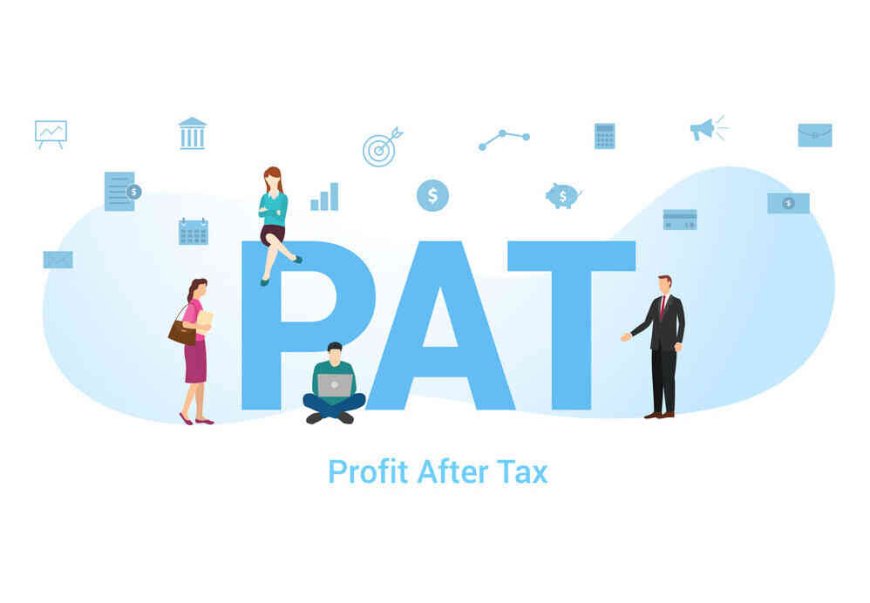INTRODUCTION TO PAT (Profit After Tax) FOR KIDS AND ADULTS

PAT (Profit After Tax) :
PAT, which stands for Profit After Tax, is a measure of how much money a business makes after paying taxes to the government. PAT is the money you have as profit after you've taken out all the costs of running your business and paid the necessary taxes. It shows how much money you've earned for yourself after taking care of everything else.
FORMULA:
PAT = PBT - Tax
In this formula, PBT represents the Profit Before Tax, which is the profit a business makes before paying taxes. Tax refers to the amount of taxes paid by the business to the government.
By subtracting the tax amount from the PBT, you arrive at the PAT, which represents the profit remaining after taxes have been deducted.
EXAMPLE: (For Kids)
1) Birthday Cake Baker:
Revenue: The total money earned from selling birthday cakes to customers.
Expenses: The costs involved in baking cakes, including the cost of ingredients, baking supplies, and other related expenses.
Taxes: The money paid to the government based on the earnings from selling cakes.
PAT: The profit remaining after deducting the expenses and taxes from the revenue earned by selling birthday cakes.
2) Ice Cream Vendor:
Revenue: The total money earned from selling ice cream to kids in the neighborhood.
Expenses: The costs associated with running the ice cream cart, such as the cost of ingredients to make the ice cream, maintenance of the cart, and other related expenses.
Taxes: The money paid to the government based on the earnings from selling ice cream.
PAT: The profit left after subtracting the expenses and taxes from the revenue earned by selling ice cream.
3) Vegetable Vendor:
Consider a vegetable vendor who sells fresh vegetables at a local market. After deducting the cost of purchasing vegetables, transportation expenses, and paying taxes, PAT is the profit the vendor has left to support their business or personal needs.
4) Handmade Jewelry Maker:
Imagine a jewelry maker who creates beautiful handmade jewelry. After subtracting the cost of materials, tools, and paying taxes from the money earned by selling jewelry, PAT is the profit the jewelry maker has available after fulfilling their tax obligations.
5) Storybook Author:
Think of an author who writes and sells storybooks. After deducting the cost of publishing, marketing expenses, and paying taxes from the money earned by selling books, PAT is the profit the author has left to invest in future projects or personal goals.
EXAMPLES: (For Adults)
1) Rental Property Owner:
Rental Income: The money you earn from renting out a property, such as an apartment or a house.
Expenses: The costs associated with owning and maintaining the rental property, including property taxes, maintenance expenses, and any other allowable deductions.
Taxes: The tax obligations that need to be fulfilled based on the rental income earned.
PAT: The income remaining after deducting expenses and taxes from the rental income. It represents the income you have available after covering property-related expenses and tax obligations.
2) Salary Earner:
Gross Salary: The total amount of money you earn from your job before any taxes are deducted.
Taxes: The amount of money that is deducted from your gross salary as per the income tax regulations.
PAT: The income you have remaining after taxes have been deducted from your gross salary. It represents the money you can use for your personal expenses, savings, or investments.
3) Business Owner:
PBT (Profit Before Tax): The profit your business generates before considering tax obligations. It is calculated by subtracting all business expenses from the revenue.
Taxes: The amount of tax that needs to be paid based on the profit generated by your business.
PAT: The profit remaining after taxes have been deducted from the PBT. It represents the income available for reinvestment in the business, personal use, or savings.
In each example, PAT represents the profit or income remaining after taxes have been deducted. It provides a measure of the actual earnings available for personal use, business reinvestment, or savings. Understanding PAT helps individuals and business owners assess their financial situation and make informed decisions in the Indian context.
CONCLUSION:
PAT (Profit After Tax) is the money left after taxes are deducted. It represents the actual earnings available for use, whether for personal expenses, business reinvestment, or savings.It shows the money left after taxes, which can be spent or saved. PAT gives a clear picture of actual earnings after accounting for taxes.
What's Your Reaction?
 Like
0
Like
0
 Dislike
0
Dislike
0
 Love
0
Love
0
 Funny
0
Funny
0
 Angry
0
Angry
0
 Sad
0
Sad
0
 Wow
0
Wow
0







































































